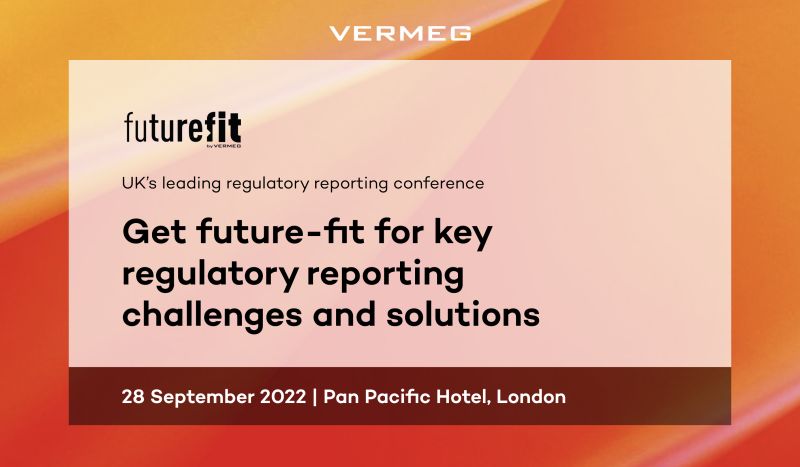Newsletter AGILE Reporter Issue 11 | Q3 | 2022

Date
FutureFit: UK Regulatory Reporting Conference
Our annual UK regulatory conference was held on 28 September at the Pan Pacific Hotel in London: “Get fit for the rapidly changing regulatory reporting challenge”.
Topics covered were:
⁄ Challenges and advantages of digitising compliance and reporting processes in the cloud;
⁄ Essential PRA and BoE reporting roadmap information, and UK onshoring from EU;
⁄ Key ESG data gathering and reporting challenges;
⁄ Crypto asset risks for reporting firms and the reporting impact;
⁄ The reinvention of how regulatory reporting is done – including the UK regulator’s Transforming Data Collection joint transformation program.
Further details will appear in next quarter’s newsletter.
EMEA – Scanning the Horizon for Regulatory Change in 2022 and Beyond
In case you missed it, our Head of Regulatory Reporting, EMEA, Hanbury Hampden-Turner, provides an overview of the regulatory landscape, including big trends and what is coming up soon, scanning the Horizon for Regulatory Change in 2022 and Beyond: know more about the latest changes by the European Banking Authority, the PRA and the Financial Conduct Authority, about the recent developments in IFPR, IFRS9, the move to BEEDS, and much more.
North America – A busy year of Regulatory updates, Q3 update
⁄ Successful implementation of the FR 2052a ‘6G’ changes
VERMEG North America has successfully implemented the revision to the FR 2052a 6G, the Complex Institution Liquidity Monitoring Report, enabling all our customers to be ready for submission to the regulators in October.
⁄ Revisions to FR 2420, Report of Selected Money Market Rates.
The revisions were designed to enable closer monitoring of the transition away from the London Interbank Offered Rate (LIBOR); strengthen the reference rate production process; and ensure the integrity of reported data. In addition, the day-count convention used for all interest rates reported on the FR 2420 reporting form has been introduced.
⁄ Revisions to Form SLT (Aggregate Holdings, Purchases and Sales, and Fair Value Changes of Long-Term Securities by U.S. and Foreign Residents)
The revisions entail the collection of the data pertaining to ‘‘changes in fair value’’ for the TIC (Treasury International Capital) securities data; and incorporating purchase and sale activities of long-term securities along with custody activities.
⁄ The FR 2956 collects detailed data on depository institutions’ daily transactions of marketable U.S. Treasury securities and of the debt and MBS issued by U.S. Federal government agencies including government-sponsored enterprises (agencies).
FR 2956 is a granular data report (“GDR”) and as such, adheres to a consistent trend in regulatory reporting, i.e., regulators are increasingly interested in collecting the data used in a report rather than the report alone. VERMEG is in the forefront of the trend, read more about GDR in APAC here.
Read more: Regulatory Reporting in the U.S. – Updates on a Productive Year
Asia Pacific – APRA updates on Credit risk reporting framework:
The Australian Prudential Regulation Authority (APRA) has released a response to submissions on proposed updates to the following reporting standards because of changes to the corresponding prudential standards:

⁄ Reporting Standard ARS 110.0 Capital Adequacy (ARS 110.0).
⁄ Reporting Standard ARS 112.0 Capital Adequacy: Standardised Approach to Credit Risk (ARS 112.0); and
⁄ Reporting Standard ARS 113.0 Capital Adequacy: Internal Ratings-based Approach to Credit Risk (ARS 113.0)
⁄ Reporting Standard ARS 180.0 Counterparty Credit Risk (ARS 180.0);
⁄ Reporting Standard ARS 221.0 Large Exposures (ARS 221.0); and
⁄ Reporting Standard ARS 223.0 Residential Mortgage Lending (ARS 223.0).
APRA mentioned that it is committed to meeting the 1 January 2023 implementation date, to complete the prudential reforms and provide ADIs with certainty for planning. To maximise the time available for entities development of reporting solutions APRA has included a copy of the publicly visible taxonomy (PVT). APRA has confirmed that ARS 118.1 will be discontinued as part of ARS 112.0 implementation.
Asia Pacific – MAS updates on related to dedicated testing period for new TBGS submissions:
A dedicated testing period, which lasts from 15th October 2022 to 15th December 2022, will be set aside for FIs to test their submissions of Version 1.0. For institutions that wish to conduct testing earlier, the testing facilities will be available from 1st October 2022. Data reported during the dedicated testing period, need not reflect institutions actual exposures, although actual production data can be used.

There are also testing scenarios specified by MAS which the banks are expected to adhere to ensure that any submission issues are identified and resolved prior to TBGS go-live.
AGILE Suite 22.3 Upgrade
Another quarter, another set of improvements to AGILE suite!
Main changes in release 22.3:
⁄ Introducing Report Templates: You can now create and save presentation templates for each return report. These templates can then be loaded next time automatically when you run that report. Any such template can be shared with other users of the system.
⁄ Password expiry email notifications: Automated email notifications, to users whose password is due to expire, are now supported for systems using password expiry, when such systems have email notifications configured. User will get daily notifications for the duration of expiry period.
⁄ Execution Group supports ARCE: All ARCE (AGILE Calcs) jobs: staging, validations, pipelines, retrieval, are now supported via AGILE Reporter’s Execution Groups. A collection of jobs can now be run with a single click.
⁄ Submit all data schedules: If a return is using data schedule submission, now you can create all data schedule submission outputs for that return in one go.
⁄ Contextual browser tab names: browser tab names are now reflecting the content of the page, for easier navigation – particularly useful when many tabs are open.
⁄ Dataset adjustments:
- Bulk Adjustments: In addition to being able to upload bulk adjustments to a dataset, you can now select multiple rows in a dataset to apply same adjustment to. You can do bulk adjustments multiple times before saving and validating;
- Filtering failed rows: To help identify data with issues, now you can filter data based on a validation rule that it failed. Any filtered data can then be corrected using bulk adjustments or bulk upload;
- Adjustment roll-back: any unsaved adjustments can be selectively rolled-back;
- Adjusted datasets indicator: Any dataset with adjustments is clearly indicated in the Dataset list view;
- Warning on changed (stale) data: When creating return allocation report on data that has changed since last retrieval, or drilling-back on a pipeline data, user is notified and advised to update.
VERMEG is delighted to achieve again IEC/ISO 27001 certification

VERMEG is delighted to announce that we have achieved IEC/ISO 27001 certification again, following a successful audit by Ernst & Young CertifyPoint of our headquarters in Tunis and the international offices in New York, London, Paris, Brussels and Luxemburg. We achieved an almost perfect score.
ISO27001 is an essential international standard for information security. This, along with our SOC II Type 2 certification, clearly indicates our commitment to delivering quality and secure services to our customers globally.
Congratulations to all VERMEG teams, and here’s to a safe and secure environment!



